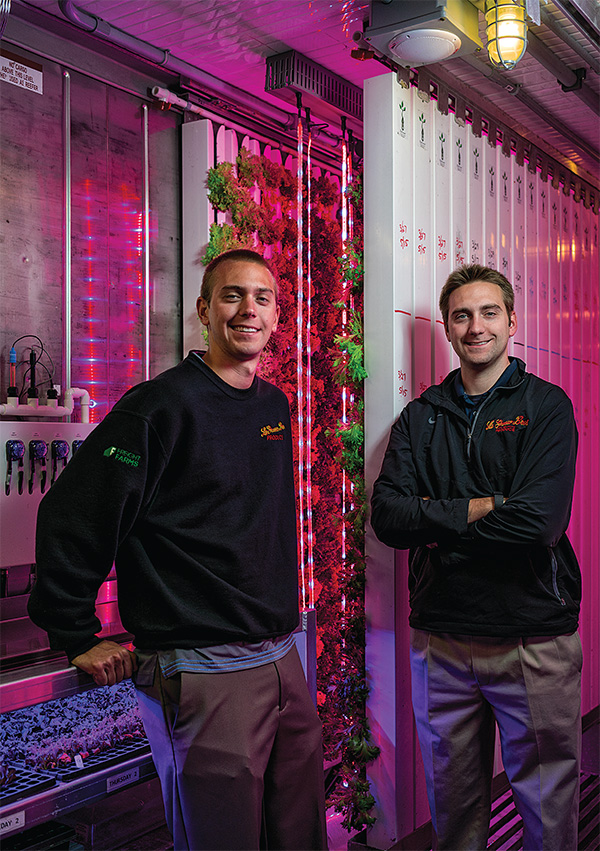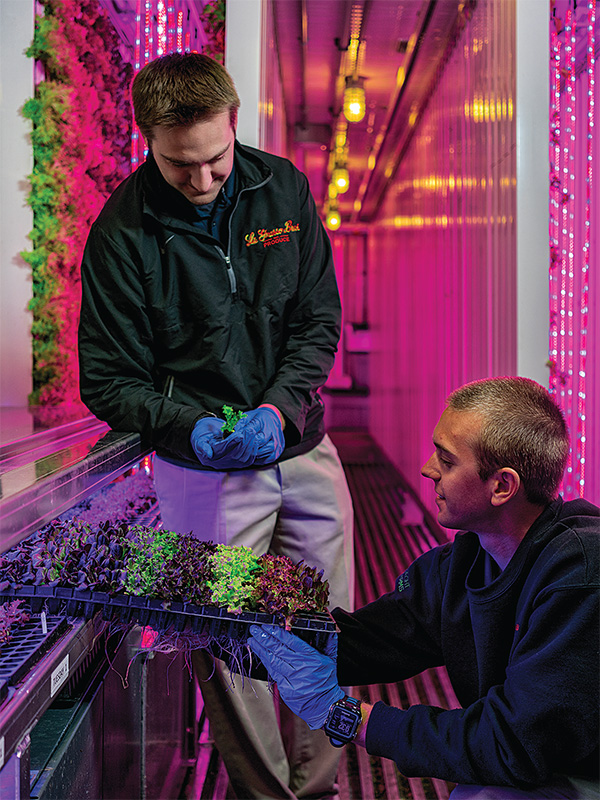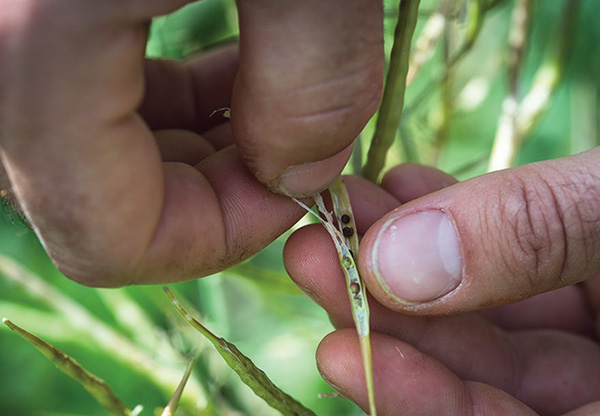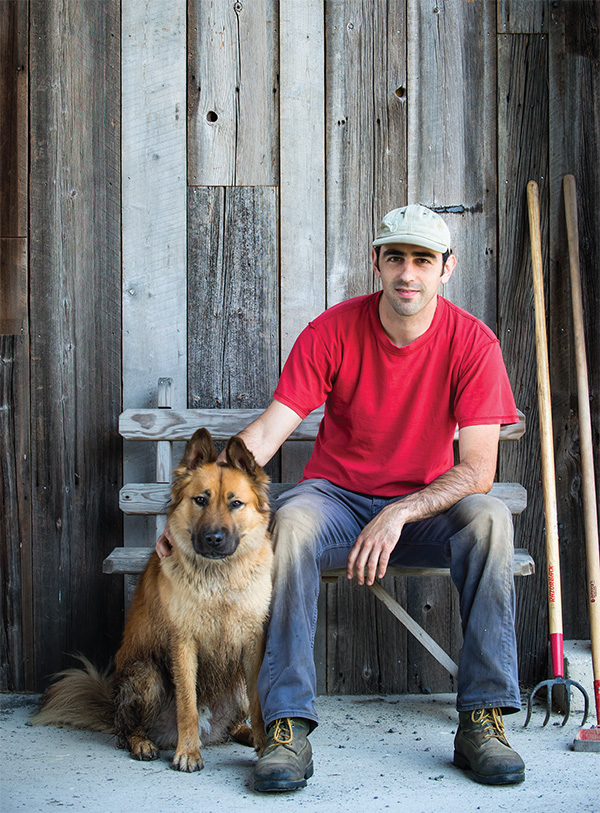
Kate ’07 and K.J., MBA’11, Neilson in front of their shipping-container-turned-farm in St. Thomas
Ken “K.J.” Neilson, MBA’11, recently acquired his farmer’s license. After studying economics in college, working in real estate for years, earning an MBA, and turning his talents to marketing, farming is not the next career move that Neilson would have predicted for himself.
But about three years ago, on somewhat of a whim, he and Kate Troiano ’07, now his wife, moved to St. Thomas in the Virgin Islands. The couple, both of whom had been commuting to jobs from Boston, were in need of a change. Corporate life and city traffic, especially during Red Sox games, had become tiresome. So after exploring a few islands and falling in love with St. Thomas, they decided to pick up and go.
Kate would keep her job at a communications firm and work remotely. But K.J. decided first to figure out life on the small island, which has a population of about 51,000 and measures only 13 miles long by 4 miles wide. He wanted to get to know the people, culture, businesses, and communities, and then devise a plan. “Kate and I come from small towns, so we know how much it means to become part of the community,” says Neilson. “I wanted a sense of the needs and what’s missing before leaping into anything.”
To keep track of his ideas, Neilson scribbled them in a notebook. High electric bills for their apartment led to energy-efficient light bulbs. Tourism drives the island’s economy, so he jotted down charter boat company and provisions for condos. He even thought about aerial drone production and photography for TV and commercials. But one problem soon stood out from the rest: lack of fresh produce. “It’s such a difficult task to get fresh produce consistently,” Neilson says.
Agriculture on the island, with its steep grades and hilly terrain, is sparse. Poor soil quality makes growing nonindigenous plants even more difficult. In nearby St. Croix, where the terrain is flatter, several conventional hydroponic farms have fared well, says Neilson, but St. Thomas can’t easily receive the goods because ferry service doesn’t exist between the islands. “To get products between the islands, you have to fly them or arrange for a freight boat, which is difficult and expensive. So you end up shipping produce from thousands of miles away,” he says, “which results in poor food quality, inconsistency, and high prices.” Residents and tourists alike, he believed, could benefit from locally grown herbs and vegetables.
As someone interested in turning around inefficient systems, Neilson was familiar with hydroponics as well as the urban agriculture movement. “When I was in real estate, I was interested in retrofitting apartments with energy-efficient products,” he says. “I would keep tabs on industries and companies that take a traditional idea, add technology, and make it more efficient. I’m passionate about it.”
St. Thomas, he realized, has similar challenges to some big cities—lack of space, quality soil, and natural resources (in St. Thomas’ case, fresh water). Electricity also is scarce and expensive on the island. While researching urban agriculture, he came across CropBox, a company in North Carolina that outfits shipping containers with computer technology and modified hydroponics to create smart, environmentally stable farms that can grow produce year-round in any climate. The company claims a 320-square-foot crate can produce as much lettuce, herbs, and greens as a conventional acre of land using 90 percent less water, and crops can be planted up to eight times a year.

Photo: Winnie Au
The 320-square-foot CropBox can produce as much lettuce as a conventional acre of land.
Neilson flew to North Carolina to meet with the owner and see the product firsthand. He also visited one of the company’s farms in Naples, Florida, which was at the Ritz-Carlton and being used by its chefs for lettuces. “They blew my socks off,” he says. Upon returning to St. Thomas, he began running the numbers. He talked to chefs and buyers and distributors and friends, asking everyone what they thought. “The more I talked to people, the more I decided that this would be a fantastic idea,” he says.
Now the next step, says Neilson, is proof of concept. The entrepreneur knows he won’t be able to convince potential backers without an actual crop. “The islanders have had so many people make promises but not follow through. They’re used to being disappointed,” he says. “Everybody is skeptical until they’ve seen it themselves.”

Photo: Winnie Au
Kate and K.J. Neilson fell in love with sunny St. Thomas. In the future, K.J. wants to take advantage of the island’s beautiful climate and use solar energy to power the farm.
So he and Kate are funding the startup. They’ve rented land, worked with the government to obtain the permits for electricity and water, and set up their crate. To figure out what to grow, Neilson worked with distributors and restaurants. He planted the first crop in July and by the end of August hopes to be supplying about 3,500 heads of lettuce each month. In terms of labor, minimal training is needed to operate the CropBox, according to its creators, and it doesn’t demand many man-hours. But Neilson wants to see how everything plays out during the coming months.
If all goes well, he has big plans for the future. “You can stack these containers, so I can have 20 containers sitting on a single acre. My goal is to have a large-scale hydro farm supplying specific types of produce so the island no longer has to get them from importers,” he says. Solar also is part of Neilson’s larger plan. When he takes the operation full scale, he wants to own three to four acres of land, half for farming and half for mitigating costs, which would include installing solar panels. Kate will help with public relations, marketing, and raising capital.
Despite encountering bureaucratic hurdles, Neilson already is thrilled with the new venture. “I love the process,” he says. “I like bringing in a container and figuring out the technology and how to grow and scale.” Since the CropBox arrived, people have started to show a lot of interest, too. “I’ve had people come up to me and say, ‘Hey, I heard about the farm,’” says Neilson. “It’s such a big thing down here, to change people’s perceptions. Everywhere I go, people can’t wait until it’s running.”
He and Kate are excited to bring a needed product to the island as well. “Whether you’re visiting for a weekend or living here for 10 years, once we get to scale, you’ll be consuming our products,” he says. “If we can help the island to be self-sustainable, that would be one of the greatest opportunities.”

Photo: Jason Keen
Joe ’15 (left) and Tom ’08 LaGrasso inside their Freight Farm
In the Heart of the City
Back in the United States, far away from the balmy Virgin Islands, LaGrasso Bros. Produce distributes fruits and vegetables to customers in Michigan and northern Ohio from its Detroit headquarters. The family-owned distributor has been operating for more than 100 years, serving mostly restaurants but also schools, hotels, and other businesses. Upon graduating from Babson, Tom ’08 and Joe ’15 became part of the fourth generation to join.
Both brothers worked in the warehouse, a 40,000-square-foot refrigerated facility, while growing up. “The summer before high school,” says Tom, who is now chief operating officer, “my mother gave me the option. You can work at McDonald’s or with your father in the business. So it was an easy decision.” The business suits the brothers. No two days are alike, they say, because their responsibilities are so varied. “You never know what tomorrow will bring,” says Tom.
Joe can attest to that. “I don’t really have a title,” he says. “I do so many things.” During high school and college, he loaded trucks in the evenings. After starting full time, he managed the fleet of 80-plus trucks and trailers that make deliveries. He since has added purchasing to his list of responsibilities and has begun dabbling in sales.
And, as of last fall, Joe became head farmer. Tucked in the parking lot behind the warehouse is a 40 by 8 by 9.5-foot shipping container, similar to the Neilsons’, where the LaGrassos grow lettuces for some of their high-end customers. “We noticed a push in the marketplace for local produce,” says Joe. “People want fresh, sustainable, local produce.” The LaGrassos wanted to fill that demand, but, living in Michigan, found it difficult to locate produce outside of the state’s short growing season.
Then they heard about Freight Farms from a good friend who also is in the produce distribution business. “Ted of Katsiroubas Brothers in downtown Boston talked with my brother about the Freight Farm that they were using,” says Joe. “I was able to go see his farm.”
Walking into the container, Joe thought, “What? Wow.” Towers of lettuce were hanging from the ceiling. Freight Farms uses a vertical hydroponic growing system that is computer controlled for year-round growing. The company claims one of its farms on average can produce as much lettuce as an acre of conventional farmland. But, unlike farmland, the container can be harvested from eight to 12 times a year. “At that point we were curious,” says Joe, “so we did more research.”
Tom crunched numbers, and Joe looked into the logistics. “A lot of my end of the work was figuring out can it be done, and, if so, how would we do it?” says Joe. The LaGrassos didn’t want to hire anyone, which would add to the cost of the farm. If Freight Farms’ labor estimates of 15 to 20 hours per week proved true, Joe figured he could handle most of the work. As backup, both Joe and Tom would attend the training offered by Freight Farms, and Joe also would train his sister, Catherine, who works for the family business, as well as a couple of employees.

Photo: Jason Keen
Tom (left) and Joe LaGrasso both say working in the farm helps clear their heads. Joe estimates that at any one point about 3,000 plants are growing in the container.
The brothers decided the opportunity to provide customers with fresh produce 52 weeks a year was worth the risk. In September of last year, the farm was delivered. The plan was to create a lettuce blend, so Joe began experimenting immediately. “We wanted a product that would be beautiful, tasty, colorful, and of a sufficient weight so a chef could use it on a larger scale,” he says. “We went through about 24 to 25 varieties of lettuce. We’d plant, and then it’s the sit-and-wait game.”
When planting, which is done by hand, Joe uses a pelleted seed, which means the seed is surrounded by clay, making it bigger and easier to handle. “If you don’t want to use tweezers and a petri dish, then you need a larger seed,” he says. The seeds germinate for about a week, and the seedlings then sit in a trough for two more weeks until they are mature enough to go into the tower. About four weeks later, the lettuces are ready for harvesting. “We have a running schedule so that when I’m pulling heads of lettuce out of towers,” says Joe, “new seedlings are going in. Babson’s operations class came to fruition.” At any one point, about 3,000 plants are growing in the farm. Joe says their special blend comprises eight types of lettuce—light and dark greens and reds—and has a spicy, nutty flavor.
As with any new endeavor, the farm has presented the brothers with challenges: a problem with the pumps, a malfunctioning air-conditioning unit. But Freight Farms offers support, as do other farmers using the system. “There’s a Facebook page that everyone who has a farm is invited to join,” says Joe. “You can post things like, ‘Hey, did anyone see this issue with their pump?’ ‘Yeah, I had that two months ago, and this is what I did.’”
The brothers say it’s too soon to determine how profitable the farm will be. Week to week, harvests vary, says Tom, and demand may change during Michigan’s growing season. He is taking a longer view, tracking data for a year or two before determining where the farm stands. Regardless, the LaGrassos don’t expect the farm will ever be more than 1 percent of their volume. Becoming full-time farmers was not the goal. “Our lettuce blend is for someone who is willing to pay a premium,” says Joe, “and our customers absolutely love it. When we harvest, we leave the roots on and dip them in water as we’re packaging, so the plants are still living when the customers receive them and can continue living and growing for a week in a cooler. It stays fresh until the chef decides to serve it.”
Joe never thought farming would be part of his job. “I had never grown a thing in my life before that farm landed on my lot,” he says. “Not a flower. Nothing.” But he loves his time with the farm. Inside the container feels like a different world. Often while harvesting, he’ll listen to podcasts. “It’s a time to get away and think about things other than work,” he says. “I’ve learned a lot. I also like seeing the reaction of chefs and managers who walk into the farm. They’re shocked when the lights go on and think it’s the coolest thing ever.”
Ideas Grow into Reality

Photo: Jennifer May
Before leasing 2.5 acres in New York to start a farm, Jesse Tolz ’08 trained for three years, studying such topics as biodynamics, plant breeding, and seed saving.
Jesse Tolz ’08 remembers the gardens that his mother and grandmother planted and cared for when he was a youth. Dense, magical gardens of flowers, shrubs, and trees. Although he loved hanging out in them and even helped a bit with the tending, he didn’t have as strong of a connection to nature then as he does today. Last year, Tolz leased 2.5 acres to start Vida farm in Ghent, New York, where he grows and sells vegetables, herbs, flowers, and seeds. “I would not have seen this one coming,” he says of his venture.
As a teenager thinking about college, Tolz had envisioned opening a cafe and boutique one day. His high school counselor told him, “You want to be an entrepreneur,” and guided him to Babson. After graduating, Tolz worked in marketing for a few years and landed in Brooklyn, New York, where he planned to open a vegan baked-goods company. He decided to drop by Brooklyn Boulders, the rock-climbing venture started by fellow Babson alumni, including Lance Pinn ’06, to see how his friends were doing. “Lance convinced me to start working at Brooklyn Boulders,” says Tolz. “I think my going there was serendipitous.”
Tolz enjoyed working for the company, and, as it grew, he participated in discussions about how to potentially expand and scale. “I was working for Lance, and we started discussing our core values,” says Tolz. “There was an exercise where we designated our most positive and negative experiences of our lives on a chart.” All of Tolz’s positive experiences were tied somehow to nature. “It got me thinking,” he says.
At Brooklyn Boulders, Tolz definitely saw a great future, with room for growth, creative freedom, and financial stability. But his intuition still told him to leave and follow his interests in the food system by exploring agriculture. “Over the years,” he says, “I’ve learned that the more I trust my intuition, the better things go for me.”
During the next three years, Tolz trained to become a farmer. He took courses at The Pfeiffer Center, a nonprofit that focuses on biodynamics, a holistic and ecological approach to agriculture. He learned about draft-horse powered farming, as well as other skills, such as orcharding, beekeeping, carpentry, and welding. “To be a farmer,” he says, “you have to be a jack-of-all-trades.”

Photo: Jennifer May
As part of his studies, Tolz did a research project on plant breeding and seed saving. “It was one of those rabbit-hole experiences,” he says. “I realized that hardly any farmers who produce crops actually produce their own seeds to improve the plants year after year.” To learn more, he worked for the nonprofit Turtle Tree Seed Initiative, which uses biodynamic methods to grow seeds, which it then sells. Next, Tolz worked in the fields at the Stone Barns Center for Food and Agriculture, a nonprofit farm and education center.
Feeling confident in his skills, Tolz made plans with a partner to start a draft-powered farm near Albany. But the day Tolz packed his car to move, the partner backed out due to financial problems. Tolz moved anyway. “I tapped my network, walking around and talking to people and asking if they knew of any good opportunities or farmland,” he says. “As I did this, I was realizing more and more that it was a sign for me to see if things I wanted to experiment with I could now take up myself.” He found a couple with farmland who were raising chickens and pigs and who wanted to lease land to a plant-based operation. Around the middle of March last year, Tolz signed on, and he began working as soon as the snow melted in late April.
Tolz had numerous ideas floating in his head, but one of his main goals was to set up a farm that wouldn’t demand a huge initial capital investment. “The minimum you usually need to get started is around $100,000,” he says. “You need to buy tractors, fencing, irrigation. You have all these requirements, but you still have to sell at commoditized prices. People expect to find the same prices as at the supermarket. So there’s not that much elasticity when it comes to pricing.”
Falling back on what he had learned, Tolz believed he could create a scalable, replicable system with capital costs of around $15,000 and aims of profitability in year two. To start, he rented a tiller and opened the land, which formerly was a hayfield but now was overgrown with weeds. After cutting up the top layer of the soil, he planted 10 low-growth legumes to become a permanent cover crop. “With a permanent cover crop, you don’t necessarily need to rely on irrigation,” says Tolz. “The cover crop itself has an absurd amount of surface area, so every morning, the dew is collected in these overlapping layers of plants,” he says, effectively watering the field while shading the soil from evaporation loss.
Also, because of the root system and diversity of plants, the soil is healthier. “If I have bare soil, there is more evaporation and runoff, not just of moisture but also of nutrients and soil life, which is bacteria, fungi, all kinds of things,” says Tolz. “There is such an invisible diversity of life. With bare soil, that’s more depleted.”
Tolz uses no pesticides, conventional or organic. The farm also is completely direct seeded, which means every seed goes into the field. Many farms, especially in the north, start plants in greenhouses and then transplant them once the weather warms. “Every time you repot a plant into a larger pot or soil, there is some degree of root shock,” says Tolz. “The idea of sowing directly is once the plant sends out its root system, it’s unrestricted by plastic walls. Not only am I cutting out the infrastructure needed to start plants indoors, my plants are healthier and more delicious. With tomatoes, I don’t know a single farmer who does direct planting of tomatoes. It gives me a competitive edge.”
With a shorter growing season, Tolz has to choose his plants carefully, as certain plants take longer to mature than others. The first year, as part of his experiment, he grew a wide variety of crops. This year, after learning what grows well in his fields, he is focusing on fewer varieties. He also is learning about which crops are more profitable. “Sweet corn, I’m not breaking even,” he says. “But kale and tomatoes have high margins.” To control pests such as deer and rabbits, Tolz has a fence and his adopted dog, Oso, which means bear in Spanish. “I’ve had him for three years now,” says Tolz. “He’s my partner in crime.”
During the season, Tolz has an on-site farm stand for weekend sales and takes orders from restaurants and other customers. In the fall and winter, he’ll sell stored crops, such as winter squashes and dried beans, to restaurants and grocers. Besides vegetables, Tolz is experimenting with developing certain plants for seeds, which he plans to package and sell.
He also has devoted half an acre to flowers, growing 33 varieties. Tolz has high hopes for this revenue stream, which he believes is not as restricted by price ceilings as the vegetables. “People spend good money on luxury items,” he says. He sells his flowers via the farm stand and takes orders from florists and individuals. Some of his flowers are edible, which he sells to restaurants. He has added wedding sales this year and is thinking about a pick-your-own-flowers option. “I’m very taken by flowers,” says Tolz. “Even though I grew up with my grandma and mother gardening, I didn’t see the real value in the aesthetics and beauty of creating a cut-flower setting. But my girlfriend, Marla, is a florist, and she’s shown me a lot about flowers.”

Photo: Jennifer May
Jesse Tolz works the farm—where he sells vegetables, herbs, flowers, and seeds—with his adopted dog, Oso.
For now, Tolz is a one-man—and dog—operation. Early in the year, he prepares the fields and plant beds. In the spring, he begins planting, tending, and weeding. Come harvest time, he waits for the field to cool down before picking, which means going out in the early morning or late evening. All year long, he also does maintenance, manages operations, handles sales and marketing, and continues to learn from other farmers and experiment with new ideas. Once he has obtained proof of his concept, Tolz wants to look for a larger farm, 10 to 30 acres, and add a draft-powered system. “Right now I’m working with small tillers to make the beds in the cover crops,” he says. “Adding horses to a farm system is a plus in my eyes. If you manage them properly, you also get manure, which is a great fertilizer. If I scale up with a tractor, the weight of that machinery would crush and kill the cover crop. Whereas the horse can be super nimble. And I love working with horses.”
Much of what Tolz is doing has no precedent. “It’s an experiment and a lot of risk,” he says. Although his financial investment has been low, Tolz has put in an enormous amount of time and energy. “This is like any entrepreneurial venture,” he says. “I’ve been working really hard, and I’m hoping it works.”
He already has reaped some rewards. Simply being able to put into practice his ideas and ideals has been worth the effort. And he loves the work. “I love seeing the crops, going into a field, and there’s a whole row of beautiful heads of lettuce or tomatoes that are doing astonishingly well,” says Tolz. “I’m interacting with the plants, and although when harvesting you’re ending the plant’s life, you’re giving this delicious product to someone who will be nourished by it and enjoy it. It’s very rewarding.”
